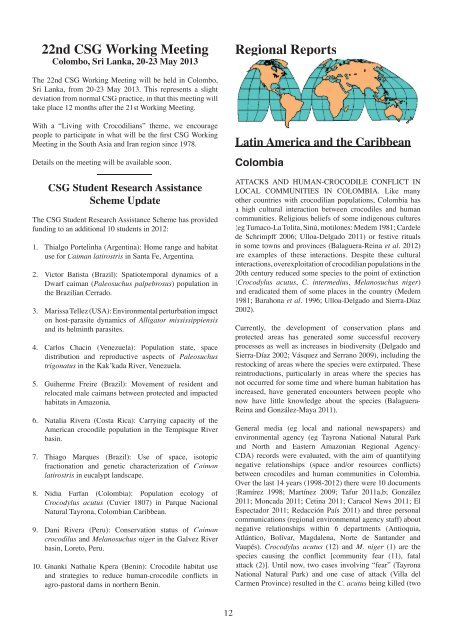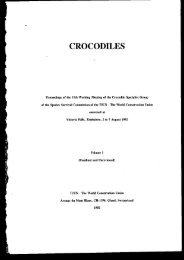CROCODILE SPECIALIST GROUP NEWSLETTER
CROCODILE SPECIALIST GROUP NEWSLETTER
CROCODILE SPECIALIST GROUP NEWSLETTER
Create successful ePaper yourself
Turn your PDF publications into a flip-book with our unique Google optimized e-Paper software.
22nd CSG Working Meeting<br />
Colombo, Sri Lanka, 20-23 May 2013<br />
Regional Reports<br />
The 22nd CSG Working Meeting will be held in Colombo,<br />
Sri Lanka, from 20-23 May 2013. This represents a slight<br />
deviation from normal CSG practice, in that this meeting will<br />
take place 12 months after the 21st Working Meeting.<br />
With a “Living with Crocodilians” theme, we encourage<br />
people to participate in what will be the first CSG Working<br />
Meeting in the South Asia and Iran region since 1978.<br />
Details on the meeting will be available soon.<br />
CSG Student Research Assistance<br />
Scheme Update<br />
The CSG Student Research Assistance Scheme has provided<br />
funding to an additional 10 students in 2012:<br />
1. Thialgo Portelinha (Argentina): Home range and habitat<br />
use for Caiman latirostris in Santa Fe, Argentina.<br />
2. Victor Batista (Brazil): Spatiotemporal dynamics of a<br />
Dwarf caiman (Paleosuchus palpebrosus) population in<br />
the Brazilian Cerrado.<br />
3. Marissa Tellez (USA): Environmental perturbation impact<br />
on host-parasite dynamics of Alligator mississippiensis<br />
and its helminth parasites.<br />
4. Carlos Chacin (Venezuela): Population state, space<br />
distribution and reproductive aspects of Paleosuchus<br />
trigonatus in the Kak’kada River, Venezuela.<br />
5. Guiherme Freire (Brazil): Movement of resident and<br />
relocated male caimans between protected and impacted<br />
habitats in Amazonia.<br />
6. Natalia Rivera (Costa Rica): Carrying capacity of the<br />
American crocodile population in the Tempisque River<br />
basin.<br />
7. Thiago Marques (Brazil): Use of space, isotopic<br />
fractionation and genetic characterization of Caiman<br />
latirostris in eucalypt landscape.<br />
8. Nidia Farfan (Colombia): Population ecology of<br />
Crocodylus acutus (Cuvier 1807) in Parque Nacional<br />
Natural Tayrona, Colombian Caribbean.<br />
9. Dani Rivera (Peru): Conservation status of Caiman<br />
crocodilus and Melanosuchus niger<br />
in the Galvez River<br />
basin, Loreto, Peru.<br />
10. Gnanki Nathalie Kpera (Benin): Crocodile habitat use<br />
and strategies to reduce human-crocodile conflicts in<br />
agro-pastoral dams in northern Benin.<br />
Latin America and the Caribbean<br />
Colombia<br />
ATTACKS AND HUMAN-<strong>CROCODILE</strong> CONFLICT IN<br />
LOCAL COMMUNITIES IN COLOMBIA. Like many<br />
other countries with crocodilian populations, Colombia has<br />
a high cultural interaction between crocodiles and human<br />
communities. Religious beliefs of some indigenous cultures<br />
(eg Tumaco-La Tolita, Sinú, motilones: Medem 1981; Cardele<br />
de Schrimpff 2006; Ulloa-Delgado 2011) or festive rituals<br />
in some towns and provinces (Balaguera-Reina et al. 2012)<br />
are examples of these interactions. Despite these cultural<br />
interactions, overexploitation of crocodilian populations in the<br />
20th century reduced some species to the point of extinction<br />
(Crocodylus acutus, C. intermedius, Melanosuchus niger)<br />
and eradicated them of some places in the country (Medem<br />
1981; Barahona et al. 1996; Ulloa-Delgado and Sierra-Díaz<br />
2002).<br />
Currently, the development of conservation plans and<br />
protected areas has generated some successful recovery<br />
processes as well as increases in biodiversity (Delgado and<br />
Sierra-Díaz 2002; Vásquez and Serrano 2009), including the<br />
restocking of areas where the species were extirpated. These<br />
reintroductions, particularly in areas where the species has<br />
not occurred for some time and where human habitation has<br />
increased, have generated encounters between people who<br />
now have little knowledge about the species (Balaguera-<br />
Reina and González-Maya 2011).<br />
General media (eg local and national newspapers) and<br />
environmental agency (eg Tayrona National Natural Park<br />
and North and Eastern Amazonian Regional Agency-<br />
CDA) records were evaluated, with the aim of quantifying<br />
negative relationships (space and/or resources conflicts)<br />
between crocodiles and human communities in Colombia.<br />
Over the last 14 years (1998-2012) there were 10 documents<br />
(Ramírez 1998; Martínez 2009; Tafur 2011a,b; González<br />
2011; Moncada 2011; Cetina 2011; Caracol News 2011; El<br />
Espectador 2011; Redacción País 2011) and three personal<br />
communications (regional environmental agency staff) about<br />
negative relationships within 6 departments (Antioquia,<br />
Atlántico, Bolívar, Magdalena, Norte de Santander and<br />
Vaupés). Crocodylus acutus (12) and M. niger<br />
(1) are the<br />
species causing the conflict [community fear (11), fatal<br />
attack (2)]. Until now, two cases involving “fear” (Tayrona<br />
National Natural Park) and one case of attack (Villa del<br />
Carmen Province) resulted in the C. acutus being killed (two<br />
12
















